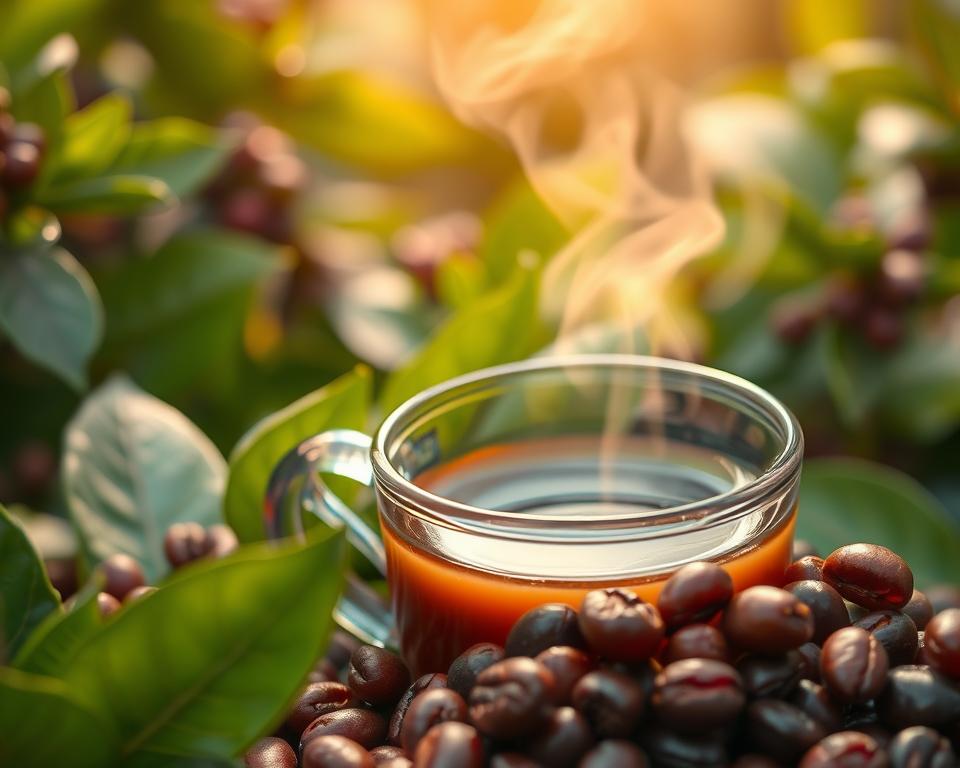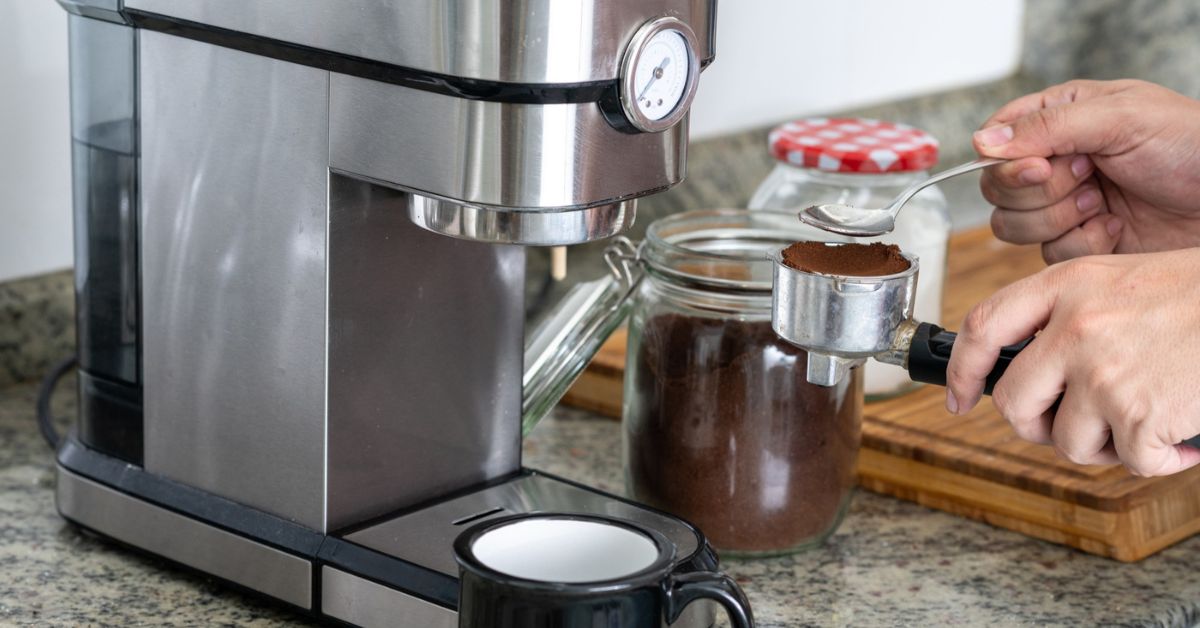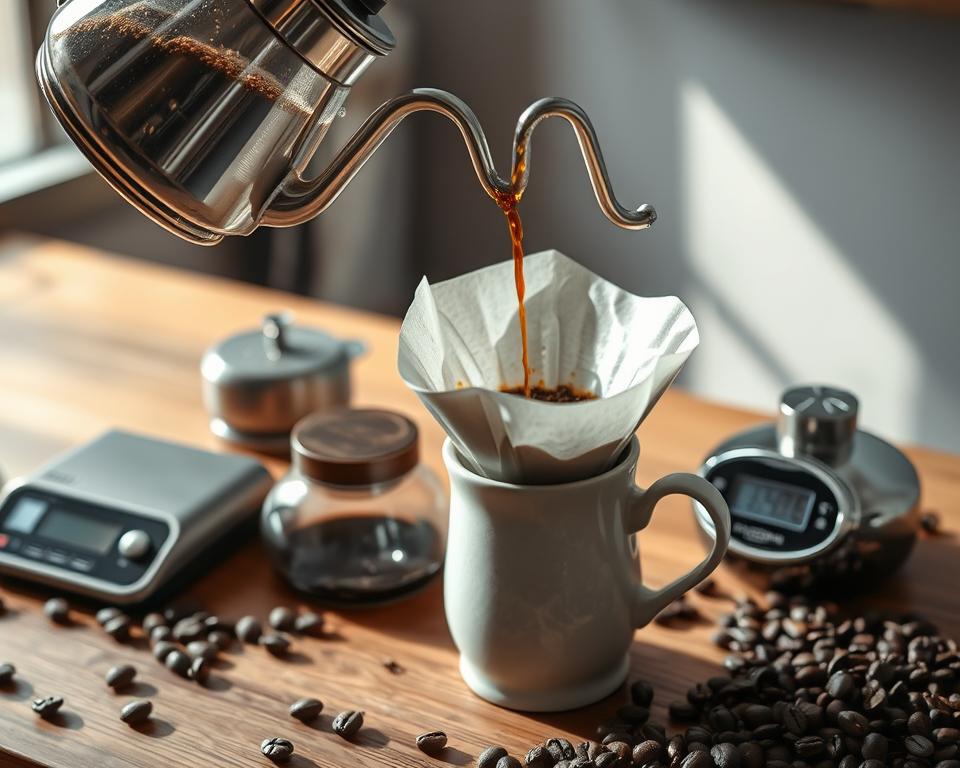The moment oxygen contacts coffee beans, freshness starts to decrease. All coffee lovers agree that keeping brew quality is key for a great cup. Oxygen, known as the “Coffee Killer,” can quickly harm flavor by attacking natural oils and aromas.
Understanding oxygen’s effect is critical for coffee fans. Once beans are roasted, they stale when exposed to air, moisture, UV rays, and temperature changes. These elements can ruin coffee freshness, making your coffee taste disappointing.
Thankfully, innovations like Modified Atmospheric Packaging (MAP) and Nitrogen gas flushing are here to help. They remove oxygen, keeping coffee fresh longer. For example, Rovema’s Aroma Perm® Gas Flushing System keeps oxygen very low, a top choice for top coffee roasters.
To get the best brew quality, aim for 3% oxygen or less. Lowering oxygen lets you enjoy the fresh, just-roasted flavor longer. Every cup becomes a delightful experience.
Introduction to Oxygen and Coffee Freshness
Keeping coffee fresh is key for a great optimal coffee experience. Oxygen is crucial for us but bad for coffee. Understanding how oxygen affects coffee is important for freshness.
Why Freshness Matters
The quality and taste of coffee depend on its freshness. Freshly roasted beans have the flavors coffee lovers want. Fresh beans bring the best taste and aroma, preventing the taste from going bad quickly.
But, how you store your coffee is very important. Using airtight containers and keeping beans away from light preserves their taste. Proper storage methods, like those shown in this 
The Role of Oxygen in Coffee Deterioration
Oxygen makes coffee beans go bad faster. It causes loss of flavor and aroma. Controlling oxygen contact is essential for the best coffee taste.
Using advanced packaging stops oxygen from spoiling the beans. Solutions like gas release valves and multi-sealed containers are key. They protect the coffee, keeping it fresh for longer.
Choosing the right storage materials matters, too. Stainless steel, ceramic, or glass containers are best against oxygen and light. They help keep your coffee fresh and tasty.
Making sure your coffee beans stay fresh improves your coffee drinking experience. It also helps coffee brands stand out. Fighting oxygen exposure with good storage boosts happiness and loyalty among customers.
The Science Behind Oxygen and Coffee Beans
Oxygen plays a key role in coffee’s taste. It interacts with coffee beans, changing their flavor and quality. This is especially true for top-notch coffee types. They’re really prone to oxidation.

Oxidation Explained
Oxidation makes coffee go stale by breaking down its complex molecules. Once coffee beans meet oxygen, they start losing their freshness. This mainly affects fats and aromatic compounds.
These are what give coffee its unique taste and smell. Good roasting can help, but oxidation is a big issue for coffee’s quality.
The Chemical Reactions in Coffee
Coffee’s chemistry is complex with many volatile and stable compounds. A key reaction involves Chlorogenic Acids found in Arabica and Robusta beans. These acids break down into bitter and sour compounds when oxidized.
Reducing oxygen contact during storage and packaging is key. This helps keep the coffee’s flavor fresh.
Using the right storage, like vacuum-sealed or nitrogen-filled containers, helps. It keeps the coffee’s flavor and aroma intact, making for a great cup.
If you’re curious about how staling affects coffee or want more details on coffee chemistry, read more here.
Packaging Methods to Limit Oxygen Exposure
Keeping coffee fresh means controlling its exposure to oxygen. Roasters use advanced packaging methods to keep their products fresher for longer. Two key techniques are Modified Atmospheric Packaging (MAP) and Nitrogen Gas Flushing.
Modified Atmospheric Packaging (MAP)
MAP changes the air inside packaging to cut down on oxygen. This technology helps keep coffee fresh by swapping out regular air for gases like nitrogen and carbon dioxide. MAP lowers oxygen levels, which extends coffee’s shelf life and keeps its flavor and aroma intact.
Nitrogen Gas Flushing
Nitrogen Gas Flushing is a favored method for preserving coffee. Nitrogen replaces oxygen in coffee bags, stopping oxidation. This keeps the coffee fresh. Some systems, like Aroma Perm® Gas Flushing System, get oxygen levels very low, up to 0.08%, which helps coffee maintain its quality and taste.
Both MAP and Nitrogen Gas Flushing are vital for keeping coffee fresh longer. These technologies ensure coffee stays flavorful, offering a great experience to drinkers. Thus, producers can ensure their coffee remains at its best for more time.
Techniques in Coffee Fermentation: Limited Oxygen Process
Innovations in coffee fermentation now include the limited oxygen process. This technique cuts oxygen during the fermentation of Ethiopian coffee. It’s interesting because it lets natural fermentation happen in sealed containers with whole cherries.
The aim is to take out oxygen and focus on the coffee cherry flavors. This enhances the fruit taste, making the coffee better. In this controlled setting, unique flavors emerge, making each brew special.
Limited oxygen processing stands out among coffee methods. It changes the usual way, adding more hands-on work in making the coffee. The result? A brew with gentle tea rose and tangerine flavors and less sharp acidity.
This method is similar to how wine is fermented, where oxygen is also key. Comparing them helps us understand flavor better, which is cool for coffee and wine lovers.
Basically, this process keeps the coffee cherry’s essence and adds to its taste. This makes every cup a unique drink.
If you want to learn more about these interesting methods, check out this resource. It dives into coffee fermentation and oxygen’s role in it.
Aeration: Enhancing Coffee Flavor Post-Brew
Aeration is a way to make coffee taste better after it’s made. It mixes air into the drink, just like with wine. This step can make the coffee feel richer and smoother. It also helps bring out special tastes like flowers and berries. By pouring the coffee from up high or stirring it well, you make sure it’s mixed evenly. This can make it less bitter. Trying different ways to add air shows the skill of a coffee maker. They aim to create unique flavors for those who love coffee.
The Process of Aeration
Pouring coffee from above is a good way to add air. It’s like how air is mixed into wine. This helps release the coffee’s aroma. Stirring the pot or cup well also helps spread these flavors evenly. These steps by a barista make the coffee smoother and tastier. It shows how changing one small thing can make a big difference in flavor.
Impact on Flavor Profiles
Aerating coffee changes its taste in a good way. From the first sip, the flavors stand out more. This method turns certain acids into others. This change makes the coffee less sharp and smoother. Aerated coffee feels fuller and can remind you of flowers, berries, and tamarind. It can be as creamy as a special kind of coffee from South India. This shows how aeration influences the taste.
Oxygen’s Impact on Brewing Coffee
Understanding how oxygen influences brewing techniques is crucial for coffee lovers. Oxygen exposure during brewing can lead to coffee oxidation. This affects the flavor and freshness of your coffee. Oxygen’s interaction with coffee’s aromatic compounds can enhance certain tastes or lead to unwanted flavor changes. Managing oxygen exposure helps preserve the roast, keeping coffee’s intricate qualities intact.
How Exposure Changes Flavor
In coffee, over 800 flavor compounds create the brew’s complex taste and smell. When exposed to air, these compounds oxidize. For instance, coffee is best enjoyed within 7 to 21 days after roasting. After this time, flavors can become less vibrant or even stale.
Consider the role of carbon dioxide, which coffee beans release after roasting. This degassing is crucial for flavor extraction. But, too much oxygen exposure can lead to a faster loss of these flavors. This affects the coffee’s overall taste.
For the best coffee, align brewing techniques with roast preservation. The ideal time to use beans is 4 to 7 days after roasting. This time frame allows for proper degassing while keeping flavors vibrant. Managing oxygen exposure lets you preserve the freshness and enjoyment of each cup.
How Does the Environmental Impact of Coffee Farming Affect Oxygen Levels in the Brewing Process?
The environmental effects of coffee cultivation can significantly impact oxygen levels in the brewing process. Deforestation for coffee farms reduces carbon sequestration, leading to lower oxygen production. Additionally, harmful practices may disrupt local ecosystems, further decreasing oxygen availability, ultimately affecting the quality and taste of your favorite brew.
Conclusion
Knowing how oxygen affects coffee brewing is key to keeping its quality high and flavors top-notch. Every step, from detailed fermentation that brings out unique flavors to preservation techniques, needs careful oxygen management. This includes advanced packaging methods.
Brew Factory’s use of one-way valve packaging helps keep coffee beans fresh. Their commitment to perfecting brewing, including controlled fermentation, offers flavors that range from sweet and fruity to deep and spicy. These advances promise a great experience for every customer.
The role of oxygen from the bean to the cup is crucial in providing high-quality coffee. The science of storing and packaging, along with careful brewing, keeps coffee’s taste rich and aromatic. It helps coffee culture grow in the US and worldwide.
FAQ
Why is coffee freshness so important?
Fresh coffee has the best taste and aroma, offering a rich experience. It’s crucial for coffee brands to keep their coffee fresh. This ensures an optimal experience for coffee lovers.
How does oxygen affect coffee quality?
Oxygen speeds up coffee going bad, hurting its flavor and smell. Known as the “Coffee Killer,” it makes coffee less enjoyable to drink.
What is the oxidation process in coffee?
Oxidation is when oxygen reacts with coffee, making it stale. This process affects Chlorogenic Acids, turning them into bitter and sour compounds.
What are Modified Atmospheric Packaging (MAP) and Nitrogen Gas Flushing?
These methods use inert gases like Nitrogen to replace oxygen. They lower oxygen levels to keep coffee fresh longer.
How does the Limited Oxygen Process work in coffee fermentation?
This method limits oxygen during fermentation, making coffee flavors stronger. It highlights unique flavors, like tea rose and tangerine, in the coffee.
What is aeration and how does it affect coffee flavor?
Aeration adds air to coffee after brewing, making it smoother and clearer in flavor. Using methods like pouring from up high or swirling can make coffee taste better.
How can oxygen exposure during brewing alter coffee flavor?
Oxygen exposure during brewing can make coffee taste worse. It’s important to avoid too much air to keep your coffee tasting great.




